Enjoy one of our favorite winter science activities for kids — searching for animal tracks in snow!
My kids are not big on going for a walk unless there’s a cool reason for being outside. For example, a walk to the playground is acceptable but a walk around the block is met with some whining at our house.
So in an effort to get them some additional outdoor time AND include something fun to do, we decided to take a winter walk and scout out animal tracks.
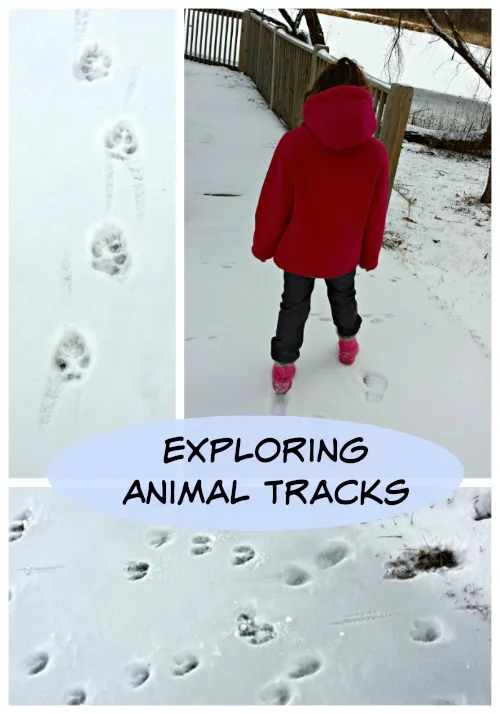
Winter STEM: Exploring Animal Footprints in Snow
Similar to our How Much Water is in Snow science experiment, this STEM activity requires a little time outside and a layer of snow!
You can also do this after a rainy day (look for animal tracks in the mud) or on a beach walk (sand is a great place to find tracks, especially for birds and shoreline mammals). Personally, I love seeing a new white canvas of snow and jump on the opportunity to go explore who else might be out walking that day.
First things first –
Bundle up before heading out!
Be sure to dress warmly so that you’ll enjoy your expedition (now that’s a great word to get the kids out for a walk!) If you’ll be walking after a rain storm, wear rubber boots. Nothing spoils the enjoyment of a nature walk quicker than cold kids 🙂 You might also consider bringing a snack and some water if you’ll be out for a while.
Grab your camera
Whether you let the kids bring the their camera or you just decide to have your phone with you. One of the main ideas of this activity is capturing what you find in photos so you can further investigate the tracks at home.
Find a Favorite Nature Book or Animal Track Guide
Having a book that identifies animal tracks will be super helpful! Since you’ll be photographing tracks on your walk, you’ll want to have something to compare them to when you return home. Here are a few recommendations along with affiliate links so you can learn more about each of the books —
Younger kids will enjoy the first two books as they have nice color illustrations, good text and include some basic ideas for nature exploration.
Big Tracks, Little Tracks: Following Animal Prints (Let’s-Read-and-Find-Out Science, Stage 1) is an easy read for younger kids. The pictures show what types of tracks you might look for along with some basic science principles too.
Whose Tracks Are These? A Clue Book of Familiar Forest Animals is the perfect book to read before a walk in the woods!
Older kids will really like Tracks, Scats and Signs (Take Along Guides) which is one in a great series of nature guides. This has more in-depth information that can be used when you are scouting out animal tracks or different signs that animals leave in nature.
How To Identify Animal Tracks
While I always love to have books at home for activities such as these, you can also use an online site to compare your photos. Animal Footprint Tracking Sheets are very helpful to print out and take with you also. Here’s a few that show a number of tracks:
- This printable Animal Track Card from the New Hampshire Fish & Game Department is an awesome resource for this activity!
- Animal Track Identification photos can also be found at The Old Farmer’s Almanac.
- And the State of Maine also offer a really nice footprint guide to animals from Maine (which can also be found in many other locations too).

Identifying Animal Tracks and Footprints
As you’re walking, be sure to go slow and look all around. Most animals don’t follow the sidewalks like we humans do. Look near bushes where the animals may bed down for the night. Also around trees as birds and squirrels will come down the tree trunk to search for food.
You’ll also want to consider what types of animals are still roaming around during the colder weather. Check out our Animals that Hibernate and Migrate activities to learn which of your furry friends may be asleep for the winter or have headed out of town 😉
When you find tracks, talk to the kids about any patterns you might see —
- Are the back tracks closer together than the front?
- How big are the tracks? After you take a photo, you might have your child put their foot print next to the track to get an idea of the animals size.
- Do you find prints that are close together? This could mean that there was more than one animal walking together or it might be that multiple animals crossed over the same area at different times.
- Is there just one set of tracks for multiple? For example, deer usually travel in small groups while rabbits and squirrels romp around individually.
All these inquisitive questions are great for encouraging scientific investigations! You can pretend you’re a nature detective trying to find out who was visiting the area over the past few days.
Kids may also enjoy taking along this free printable Winter Scavenger Hunt too! Encourage them to identify seasonal changes while their out scouting for animal footprints.
Once you get home, grab a cup of cocoa to warm up and pull up the photos you took so you can compare them to the different animal prints.
We found a number of tracks on our walk:
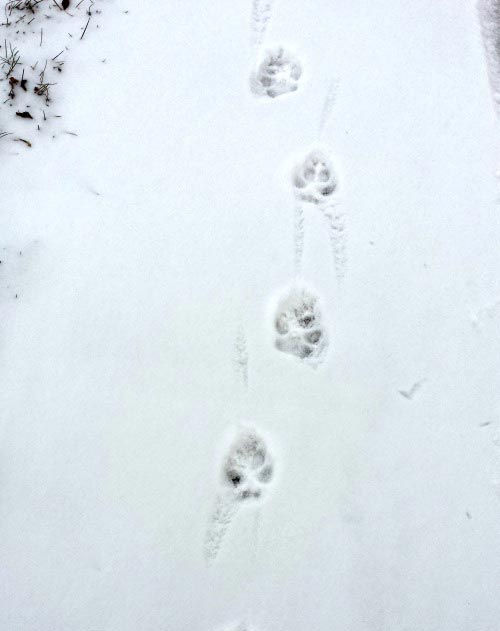
Dog Footprints in Snow
One the way to the park, we followed the tracks of a dog and their owner. When we compared the tracks to our tracking sheet. You can see that dog/wolf/coyote tracks have small points at the top of the track where the nails also leave an impression. Plus, these tracks were following the sidewalk so we knew it wasn’t a wild animal.
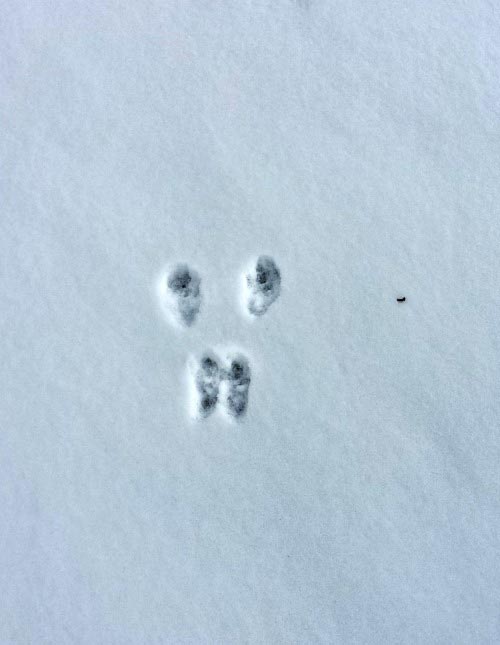
Rabbit Tracks in Snow
The first set of tracks we saw in the park were these cottontail rabbit tracks. Again, the tracking sheet helped us identify them quickly. We could see that the back legs are closer together than the front and there was a large space between each set of tracks. Thus, we were also able to tell how far the bunny hopped. The tracks led into a group of bushes which we think is where the rabbit den is located.
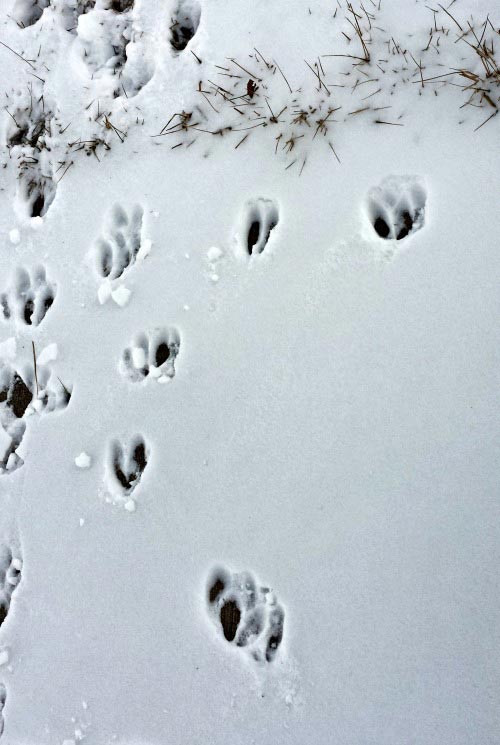
Deer Tracks in Snow
Now this is what I was hoping we’d find — deer tracks! We frequently see deer in this park especially in the evenings. Deer tracks have a sort of teardrop shape to them and are pretty deep in the snow due to the weight of the animal. We found quite a few in one spot that led to/from the large wooded area near the park.
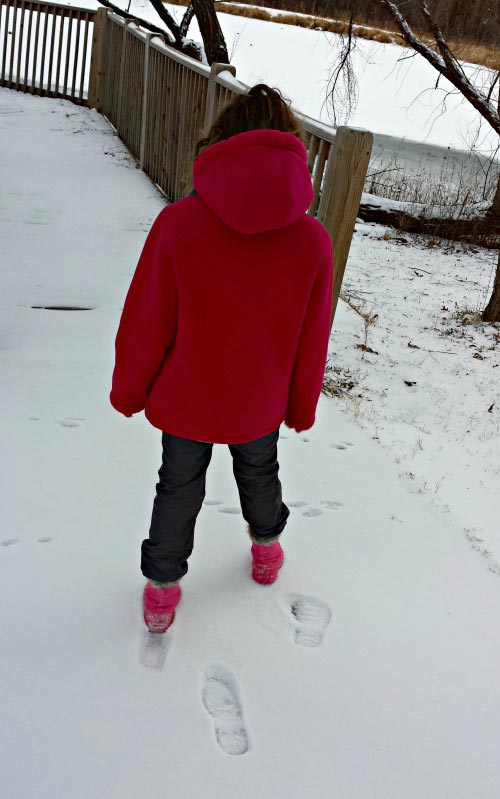
And of course we made our own tracks too! You can see right in front of my daughter that there are a few sets of animal tracks. We were comparing her boot tracks to the others that we found on the path — in this case, it was another cottontail rabbit.

Other Animal Tracks in Snow
When we came upon these tracks, we were stumped for a while.
First, you can see there are two sets of tracks in the photo. We think the ones in the upper right (that look like long claws) belong to a red squirrel. The chart we used shows that squirrels leave four footprints in a group whereas a raccoon (our other guess) only leaves two footprints in one area.
The second set of tracks look to be something cat-like. I say that because neighbors have reported sightings of a bobcat in the park and woods. Maybe? They could also be a large outdoor house cat too.
All in all, it was a pretty successful outing and definitely a fun idea for a winter walk!
You might also like:

